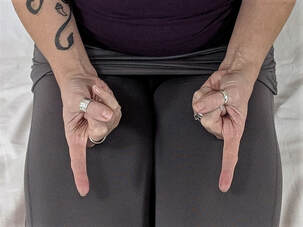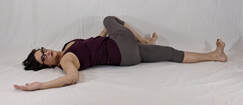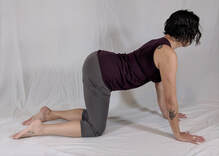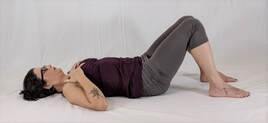|
Cheryl Fenner Brown, C-IAYT, E-RYT 500 Yhis article also appeared in the Yoga U Online Wellness Blog, May 2019 One of the most distressing side-effects of cancer treatment is lymphedema, a swelling of the extremities caused by damage to the lymphatic system. The lymphatic system is part of the immune system and consists of nodes, vessels and organs that transport lymph throughout the body. Lymph transports white blood cells through lymph nodes which are grouped in the throat, underarms, abdomen and groin. These nodes store cells that help to fight infection and filter the lymph before it returns to the bloodstream. If cancer treatment damages or removes lymph nodes, lymph builds up in the surrounding tissue causing painful swelling, or lymphedema. During breast cancer treatment, lymph nodes are often removed and tested for cancerous cells. The symptoms of lymphedema may occur immediately or up to 5 years after treatment. According to one survey, between 50-75% of women who had lymph nodes removed as part of breast cancer treatment worried about developing the condition while less than 20% developed the condition (1). Patients with lymphedema can experience a range of symptoms besides swelling of the limb and digits including pain, limited range of motion, increased risk of infection, sensitivity, hardening or thickening of the skin. (2) Lymphedema treatments include manual lymph drainage, elevation of the affected limb, compression garments, breathing exercises and movement. (3) Yoga and Lymphedema Unlike the circulatory system which has the pumping heart to move blood through the vessels, the lymphatic system relies on the body’s movements to circulate lymph. The deep diaphragmatic breathing and simple repetitive movements of the hands, arms, neck, torso and hips that are involved in many forms of yoga all help the lymph to flow optimally. Yoga also helps to increase range of motion and strength which can help to counter the impact of lymphedema, so long as the yoga is practiced slowly and gently. There are a few yoga poses that are contraindicated for those with lymphedema; handstand (adho mukha vrksasana), forearm balance (pincha mayurasana), downward-facing dog (adho mukha svanasana), headstand (sirsasana), shoulderstand (sarvangasana), and plow (halasana) all put too much pressure on the arms, shoulders and neck and should be avoided. If the lower extremities are affected, poses that create too much compression on the legs should also be avoided such as lotus (padmasana) or child’s pose (balasana) with deeply bent knees. Yoga Practice Tips
 Intention with Anushasana Mudra One of the tools of yoga is practicing mudras which link the physical and energy bodies. Here use Anushasana mudra to activate vyana vayu, the pranic current theat moves from the center of the body towards the extremities and supports lymphatic circulation.
 Reclining Floor Flow The reclining floor flow is a simple series of movements that massages the lymphatic structures in the armpits, abdomen and groins. It can also alleviate pain in the hips, lower spine and shoulders. This practice can be done on the floor or on a bed.
 Cat/Cow (Marjaiasana/Bitilasana) This common series of poses is a simple way to move energy and lymph throughout the torso and can be done kneeling on the floor or seated in a chair.
 Child’s Pose to Extended Hero’s Pose (Balasana to Utthita Virasana) Moving from Child’s Pose (Balasana) to an extended spinal position mobilizes prana, or vital energy in the body and can help to activate stagnant lymph.
 Three-Part Breath (Dirga) Breathing deeply is part of traditional lymphedema treatment as it increases the movement of the diaphragm and massages the lymph nodes located deep within the abdominal cavity. The full yogic breath, or Three-Part Breath can be practiced while seated in a chair or reclining on the floor or bed. I often imagine the breath like an elevator car moving up and down along an elevator shaft as I practice this pranayama.
 Instant Maui Elevating the legs encourages lymphatic drainage back toward the torso and is very easy to do at home. Some doctors recommend that the legs be elevated above the heart for at least 30 minutes 3-4 times a day for maximum benefit (4). Take care when positioning your body to be sure that your feet are elevated above your knees, your knees above your hips, and your hips above your heart to ensure excess fluid travels back toward the torso where it can be re-circulated into the blood stream. This posture is also mild inversion that provides a change in our perspective encourages deeper breathing, energy absorption and relaxation. Find a piece of furniture in your home such as a soft chair, sofa seat or ottoman to use for support.
Even though lymphedema can be an uncomfortable side-effect of cancer treatment, these simple yoga practices can boost immunity, release tension, increase lymphatic drainage and help the body to find more balance. Happy practicing and namaste’.
References
0 Comments
Leave a Reply. |
Index:Archives:
September 2022
I attend Cheryl's class regularly and feel that my practice has improved immensely over the past few years due to her expert coaching. Her teaching style is clear and compassionate and her previous experience in teaching adults is evident in her organized approach and easy to understand instructions. I also appreciate that Cheryl not only teaches us about how to correctly position ourselves, but also touches on many aspects of yoga philosophy, which in turn has deepened my personal practice and heightened my awareness of the connection between mind and body, breath and relaxation. |

 RSS Feed
RSS Feed
